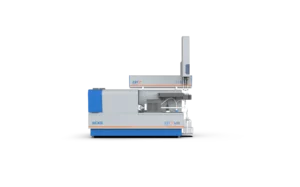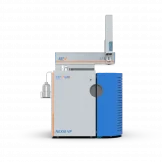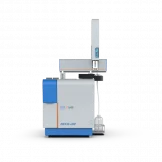ASTM D5453
ASTM D5453 is the Standard Test Method for Determining Total Sulfur in Light Hydrocarbons, Spark Ignition Engine Fuel, Diesel Engine Fuel, and Engine Oil by Ultraviolet Fluorescence
The Total Sulfur content in automotive fuels is a key parameter when undertaking process/quality control analyses. Therefore this process ensures the compositional specifications in finished refinery products are met. Sulfur components in process feeds may damage the catalyst performance in refinery processes. Thus lowering the refinery efficiency and profitability. Additionally, restrictions by regional and international regulations, such as the Tier 3 program effect the Total Sulfur content in products. Monitoring must use reliable methods and instrumentation. Accordingly the American Standardization of Testing Methods (ASTM) published the ASTM D5453 method specifically for the petroleum industry. It covers the determination of the total sulfur content in liquid petroleum products by ultraviolet fluorescence detection.
Working range Total Sulfur: 1.0 8,000 mg/kg
Boiling range: 25 400 C
Viscosities of samples: 0.2 20 cSt (mm2/s) at room temperature
Sample Types: Naphthas, Distillates, Engine Oil, Ethanol, Fatty Acid Methyl Ester (FAME); Engine Fuel such as Gasoline, Oxygen Enriched Gasoline (Ethanol Blends, E-85, M-85, RFG), Diesel, Biodiesel, Diesel/Biodiesel Blends, Jet Fuel
Enhanced Stability Performance Test of Total Sulfur in Diesel Fuel - ASTM D5453
ASTM Method D5453 is commonly used to determine Total Sulfur in liquid hydrocarbons. Therefore the boiling range of these hydrocarbons can vary from 25 to 400 C. In addition, this method calls for oxidation into sulfur dioxide (SO2) by direct injection or placed in a sample boat and then inserted into a high temperature tube for combustion. Accordingly, exposing the sample to ultraviolet light will allow detection by a photomultiplier. This application note will examine the Total Sulfur content of diesel fuel samples using the NEXIS Total Nitrogen/Total Sulfur combustion analyzer.
Excellent Precision in Total Sulfur Analysis for Gasoline and Diesel - ASTM D5453
ASTM D5453 covers the determination of Total Sulfur in concentrations ranging from about 1 to 8000 mg/kg in a wide range of liquid hydrocarbons and automotive fuels having a boiling point range of 25˚C to 400˚C and viscosities between 0.2 and 20 Cst (mm²/s) at ambient temperature.
Accordingly, sulfur compounds can have detrimental effects on many environmental and industrial processes and are undesirable in finished products. Therefore this supports the need and importance to monitor trace level sulfur concentration of various type of automotive fuels and related products. This Application Note shows the analysis performance of a set of automotive fuel samples. In addition, the system design and methodology of the EST & TSHR NEXIS Total Sulfur analyzer is thoroughly tested for response linearity and repeatability, to validate its performance according to ASTM D5453.
Total Sulfur in Automotive Fuels by Combustion and UV-F Detection Compliant to ASTM D5453
ASTM D5453 covers the determination of Total Sulfur in concentrations ranging from about 1 to 8,000 mg/kg in a wide range of liquid hydrocarbons and automotive fuels having a boiling point range of 25˚C to 400˚C and viscosities between 0.2 and 20 Cst (mm²/s) at ambient temperature.
Therefore Sulfur compounds can have detrimental effects on many environmental and industrial processes and are undesirable in finished products. This supports the need and importance to monitor trace level sulfur concentration of various type of automotive fuels and related products. Accordingly, this application note shows the analysis performance of a set of automotive fuel samples. In addition, the system design and methodology of the EST & TSHR NEXIS Total Sulfur analyzer is thoroughly tested for response linearity and repeatability, to validate its performance according to ASTM D5453.
*Accurate Determination of Total Sulfur with Nitrogen Interference - ASTM D5453-19a
ASTM Method D5453-19a describes the combustion and Ultra Violet Fluorescence (UV-F) detection of Sulfur in light hydrocarbons, engine fuels and oils. However, even an optimized detector may identify nitrogen oxide as Sulfur dioxide, as they both emit at the same wavelength. Therefore this problem can result in false positives or biased total sulfur data. EST & TSHR have developed an integrated tunable Nitrogen Oxide interference elimination module, called the TRINITYTM Module. This new module ensures there is no interference when analyzing high nitrogen containing samples thus delivering accurate total Sulfur data.
To comply with ASTM D5453, EST & TSHR offer the NEXIS TS, NEXIS VP TS and TS 6000/7000 series including combined instrument configurations with fully automatic liquids injection. Accordingly, this is provided by the AS120 Liquids Autosampler configurations. In addition, we recommend the use of boat inlet technique when analyzing high boiling point and viscous samples.





